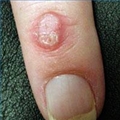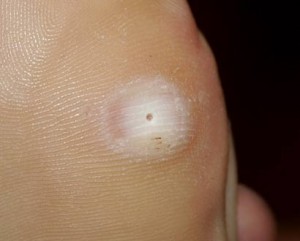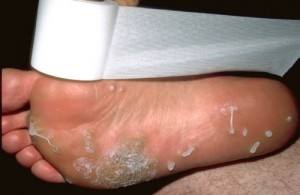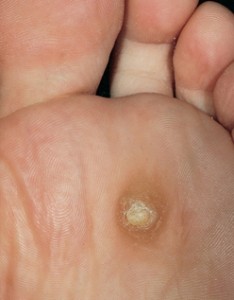Plantar Warts are small blister-like rough growths or warts that can be seen developing on the toes, hills or soles of the feet. These are a type of epithelial tumors that cause rough skin eruptions. They are caused by the Human Papilloma Virus 1, 2, 4 and 63. Warts growing essentially on feet are called Plantar Warts. However, warts growing on other parts of the body are not named in the same way.
Verruca Plantar Warts
Page Contents
- 1 Verruca Plantar Warts
- 2 What causes Plantar Warts?
- 3 What do Plantar Warts look like?
- 4 Mosaic Plantar Warts
- 5 Plantar Warts Symptoms
- 6 Plantar Warts in Children
- 7 Are Plantar Warts Contagious?
- 8 Can Plantar Warts cause Genital Warts?
- 9 Plantar Warts on Hands
- 10 Plantar Warts Treatment
- 11 Plantar Warts Pictures
- 12 Home Remedies for Plantar Warts
- 13 Plantar Warts and Duct Tape
- 14 Immunotherapy
- 15 Other Medications
- 16 Plantar Warts Prognosis
- 17 Plantar Warts Prevention
Plantar Warts are also known as Verruca Plantaris or Verruca Plantar Warts.
What causes Plantar Warts?
Plantar Warts are caused by the Human Papilloma Virus. Generally, these viruses exist in moist environments like:
- Swimming pools
- Public showers
- Lockers rooms
- Public Common Rooms
- Bathrooms
Walking on these areas in bare foot can lead to contamination. The skin gets contaminated by coming in contact directly with the virus through abrasions or scrapes on the skin or tiny wounds in the stratum corneum, the most peripheral layer of the skin. Appearance of warts might take place several weeks or even years after contamination. While walking, pressure is applied on soles of the feet which result in the wart being pushed inward. A skin covering may be formed over the virus-infected wart. These warts can cause pain if they are left untreated and make walking difficult. They are quite frequent and can be seen to develop in people of all ages. A skin trauma or a vulnerable immune system might add to the risks of getting infected by warts.
Picture 1 – Plantar Warts
Source – plantar-warts.net
What do Plantar Warts look like?
The appearance of Plantar Warts may vary from one person to another. However, they generally have a firm shell with small dots inside. They can be thick, rough and bumpy and might have a brown or grayish-yellow colored smooth surface. They are much similar in appearance to calluses and the two are often confused. Warts occur in various sizes and shapes and are filled with blood which gives it a dark color.
Mosaic Plantar Warts
Several warts can fuse together to form one or several flat clusters. These clusters are called Mosaic Warts and can vary in size.
Plantar Warts Symptoms
Warts on feet are easier to spot as they may cause a sensation of walking with a pebble in your shoe. This might make it difficult for you to walk properly or run. The skin affected by wart becomes dark or can have dark spots on them. Only the part of the wart that is protruding out on the surface of the skin can be seen from outside. Pain usually accompanies the development of warts on feet. Doctors can easily diagnose these warts simply by looking at their appearance. They might also ask for a sample of the affected skin to make some additional tests and check whether it is a callus or some benign or cancerous growth on the skin surface.
Plantar Warts in Children
These warts are more commonly found in children. Adults generally have a stronger immunity than young ones. As a result, they are not as vulnerable to warts as children are.
Are Plantar Warts Contagious?
The Human Papilloma Virus that causes warts generally spread from one person to another. It happens while people hang out in swimming pools and public showers where walking on moist surfaces are a common occurrence. Hence, it can be said to be contagious.
However, one should not suppose that every human being can contract this disorder. The strength of immunity of a person also plays a vital role in determining whether he or she will contract this condition. A person with a low immunity will be affected by these warts while someone with a good immunity will remain unaffected. These warts are also often spread in a home environment. A person having these warts may pass it on to another family member if both share the same sink or the same shower. Scratching an area of the foot infected with warts is risky as it might spread the infection to the other parts of the body when touched by contaminated fingers.
Can Plantar Warts cause Genital Warts?
Genital warts or Condyloma are warts that are found on the genitals and the pubic region, in the thighs, the vagina and in the anal canal. These warts are caused by the same Human Papilloma Virus that causes the Plantar Warts. Genital Warts and Plantar Warts are considered to be two distinct varieties of warts as the latter affects only the feet of a person. The word “Plantar” refers to a tissue at the sole of a person’s feet.
Plantar Warts on Hands
One can develop wart-like-growth on their hands. Warts growing on hands are either common warts or flat warts. As aforesaid, these warts basically grow on the sole of the feet. The type of virus causing warts on hands or the feet are naturally the same. Different names are only used to denote warts based on their locations.

Picture 2 – Planter Warts Photo
Source – natural-remedies-review.com
Plantar Warts Treatment
Treatment of Plantar Warts often seems unnecessary, as the warts appearing on the skin of the foot are found to disappear suddenly. This can eventually happen over a short or even a long period of time due to the immune system of the body. At other times, these warts can be difficult to remove and new warts may grow as soon as the old warts are removed. They can spread from one place to another and can be quite persistent. While dealing with these warts, doctors prefer to use mild treatments at first with moving on to more radical treatments later on if the initial treatments do not work. In some extreme cases skin anomalies such as redness, immense pain, swelling or bleeding may arise for which immediate treatment of warts becomes necessary.
Various types of treatments are prescribed for the removal of warts. These are as follows:
Over the Counter Medication
Several over the counter treatments are available to treat warts. These include applying patches of Cantharidin or Salicylic Acid and use of duct tapes. There are no oral medications available for the removal of warts.
Surgical Removal
Sometimes, a surgery may be required to remove a wart. Surgical procedures include burning or cauterizing and cutting of warts. A wart may be removed by electrodessication (ablation by an electrical device) or simple use of a scalpel. Ultrasonography is also used for surgical removal of warts. Local anesthesia is used as these procedures are painful. Surgeries are likely to leave scars. Excision of Plantar Warts is not advisable as this may leave scars and lead to the re-growth of warts in the future.
Laser Removal
A laser surgery involves removal of HPV Plantar Warts by using laser ray. This process is expensive.
Cryotherapy or Freezing
Cryotherapy is a process where warts are removed by super-freezing the affected tissue. Liquid nitrogen is applied on the affected area by cotton-tipped applicators or by spray which results in blistering and blackening of the warts. Following application, a wart falls off within a few weeks. This process causes no scarring of tissue and can be done at a doctor’s chamber or at home.
Cantharidin
Cantharidin is a corrosive chemical secretion that is extracted from a blister beetle. This substance has been used to heal warts for a long time. Cantharidin is often used in combination with salicylic acid which increases the effectiveness of the treatment. Cantharidin is applied over the wart and the affected area is then covered with a bandage or a dressing. This painless treatment allows the dead tissues to be removed from the infected areas. The treatment needs to be repeated several times for it to work properly.
Salicylic Acid
Keratolytic chemicals like Salicylic Acid are used in a way similar to Cantharidin. Following application over the wart, the dead skin cells can be removed which gets rid of the warts. Solutions of salicylic acid can be made in white soft paraffin or lactic acid. A solution of salicylic acid should have an acid strength of at least 40% or more for effective removal of Plantar Warts. The process should be repeated twice per day. The wart tissues and dead skin should be removed at regular intervals with an emery board or a pumice stone. The acid takes time to work. Due to this, the application needs to continue for a few weeks to a few months to ensure complete removal of warts.
Chemotherapy
Chemotherapy provides effective cure for warts. Glutaraldehyde is a virus-killing chemical used to sterilize surgical instruments. A solution of dilute glutaraldehyde is an effective Plantar Warts removal agent. These warts can be removed by other powerful chemicals, such as
- Dichloroacetic acid
- Formaldehyde
- 5-fluoro-uracil
- Retinoids (like Tretinoin and Isotretinoin)
Alternatively, a cream or a lotion containing tretinoin may be applied to have the same effect.
Vaccination
At present, there are no vaccinations for the treatment of these warts.
Plantar Warts Pictures
Check out the pictures of Plantar Warts to know about the condition.

Picture 3 – Plantar Warts Image
Source – plantar-warts.net

Picture 4 – Planter Warts Picture
Source – plantar-warts.net
Home Remedies for Plantar Warts
Homemade remedies for warts include medicinal remedies like applying apple cider vinegar with a cotton dressing. This process has to be continued for some time and after about three or four weeks the skin affected by warts will get completely healed.
Alternatively, Cantharidin and Salicylic acid patches may also be used at home to get rid of these warts.
Plantar Warts and Duct Tape
These warts can be removed by application of duct tapes in the contaminated area. The duct tapes result in rise of irritating symptoms in the affected area. After some time, the natural immune system of the body takes control and heals the affected area. The warts can be covered by duct tapes for six days. After that, the infected surface is soaked in water and gently scrubbed with an emery board or pumice stone. This process is repeated for two to three months until complete removal of warts. The process is completely painless. It is a popular method of curing warts, especially in children who are reluctant to go through painful removal processes.
Immunotherapy
Immunotherapy is a process by which by the immune system of the body is boosted. This helps to cure warts naturally from the inside. The warts may be injected with medication or an antigen which stimulates the auto immune system. Often mumps antigens are used to have the desired effect. Doctors can also prescribe Imiquimod, which is an immunotherapy medication. Imiquimod helps release cytokines which destroy the warts.
Other Medications
An alternate way of dealing with these warts is to inject each of the warts with a glycopeptide antibiotic called Bleomycin. Bleomycin kills Human Papilloma Virus (HPV). The medication is usually applied in large doses under the supervision of doctors. The process can be painful, causing itching, eruptions and rashes. This method of cure is not advisable to be used on pregnant or lactating women. People with circulatory problems should also avoid this method.
Plantar Warts Prognosis
Plantar Warts mostly heal naturally due to an active human immune system. At other times they might be difficult to heal. As of now, there exists no curative method that can guarantee a complete healing. Most people try out different techniques to get rid of warts. If left untreated, they can cause a lot of pain. Sometimes, the curative method may leave scars which can again pose as a serious problem. Warts can take anywhere between a few months to a few years to heal. They are a nuisance while they last and can cause pain, bleeding and problems while walking. In some rare cases, a wart might grow to develop a malignant cancer. Even after warts get healed, the results often prove to be temporary and the affected person can be infected by warts again.
Plantar Warts Prevention
Some preventive measures need to be taken to avoid being infected by warts or prevent the spreading of an already existing infection. These are as follows:
- Walking directly on moist surfaces like swimming pools and public washrooms should be avoided.
- Getting in contact with warts on other people as well as oneself should be avoided.
- Care of the feet should be taken by regularly keeping the feet clean and using fresh socks.
- Warts should not be scratched as this can spread the infection to other places.
- Attention should be given to any changes or growths in the skin. The skin should be protected at all times.
- Shoes, socks and bathing garments like towels should not be shared.
- Hands should be frequently washed to avoid spreading of infections.
- Warts are needed to be covered with tapes or bandages while showering or swimming.
Plantar Warts often do not cause any serious health issues. However, it is advisable not to ignore them when they first start growing, as they might get more severe at a later stage. Regular feet care will not allow them to be infected by warts.
References:
http://www.wartsremedy.com/WartsRemedy-Plantar.html
http://www.yourfoothealth.com/plantar-warts.html
http://www.emedicinehealth.com/plantar_warts/article_em.htm
http://www.ncbi.nlm.nih.gov/pubmedhealth/PMH0001888/

